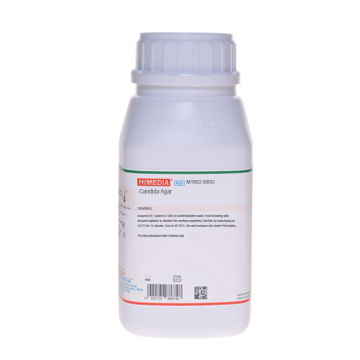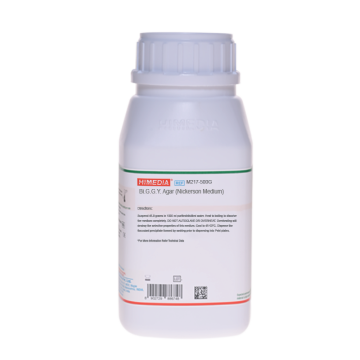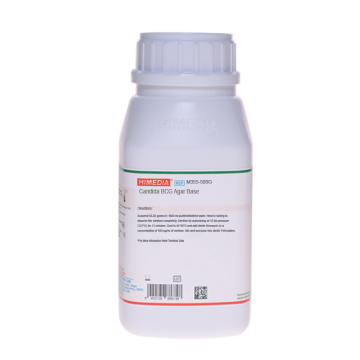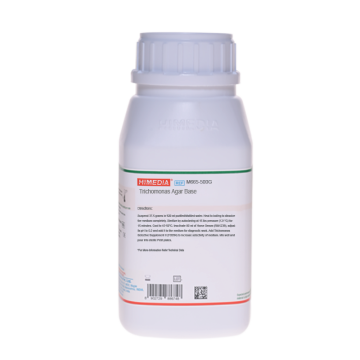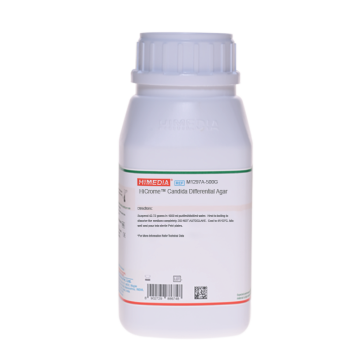 Your enquiry has been submitted
Your enquiry has been submitted
Pagano Levin Base
Intended Use
Recommended for isolating and differentiating Candida species.
Composition
| Ingredients | g/L |
|---|---|
| Peptone | 10.000 |
| Yeast extract | 1.000 |
| Dextrose (Glucose) | 40.000 |
| Agar | 15.000 |
Final pH (at 25°C): 6.0±0.2
**Formula adjusted, standardized to suit performance parameters
Directions
Suspend 33.0 grams in 490 ml purified/distilled water. Heat to boiling to dissolve the medium completely. Sterilize by autoclaving at 15 lbs pressure (121°C) for 15 minutes. Cool to 45-50°C. Aseptically add 5 ml of TTC solution 1% (FD057). Mix well. Then add 5 ml of rehydrated contents of one vial of Neo Selective Supplement (FD174). Mix well and pour into sterile Petri plates.
Principle And Interpretation
Pagano Levin Base prepared as per the formulation of Pagano, Levin and Trejo (1) is used for the isolation and differentiation of Candida species. Differentiation is based on the ability of Candida species to reduce TTC (2,3,5-Triphenyl Tetrazolium Chloride). TTC is a redox indicator which is colourless in the oxidized form and when reduced forms an insoluble red triphenyl formazan compound which appears as red coloured colonies (2). Pagano Levin Base is superior to Sabouraud Dextrose Agar in detecting yeast species (3).
Peptone provides carbon and nitrogen source required for good growth of Candida species. Yeast extract provides vitamins and cofactors. Dextrose is an energy source. TTC Solution 1%, added to the basal medium, facilitates the differentiation of yeast colonies based on the color change that occurs when Candida reduces TTC. Neomycin helps to inhibit growth of most of the accompanying bacteria.
Type of specimen
Clinical samples
Specimen Collection and Handling
For clinical samples follow appropriate techniques for handling specimens as per established guidelines (4,5).
After use, contaminated materials must be sterilized by autoclaving before discarding.
Warning and Precautions
In Vitro diagnostic Use only. For professional use only. Read the label before opening the container. Wear protective gloves/protective clothing/eye protection/ face protection. Follow good microbiological lab practices while handling specimens and culture. Standard precautions as per established guidelines should be followed while handling clinical specimens. Safety guidelines may be referred in individual safety data sheets.
Limitations
- Further wet mount examination of infected material should be done.
Performance and Evaluation
Performance of the medium is expected when used as per the direction on the label within the expiry period when stored at recommended temperature.
Quality Control
Appearance: Cream to yellow homogeneous free flowing powder
Gelling
Firm, comparable with 1.5% Agar gel
Colour and Clarity of prepared medium
Light amber coloured slightly opalescent gel forms in Petri plates
Reaction
Reaction of 6.6% w/v aqueous solution at 25°C. pH: 6.0±0.2
pH
5.80-6.20
Cultural Response
Cultural characteristics observed with added TTC solution 1% (FD057) and Neo Supplement (FD174), after an incubation at 35-37°C for 18-48 hours.
| Organism | Inoculum (CFU) | Growth | Recovery | Colour of Colony |
|---|---|---|---|---|
| Candida albicans ATCC 10231 (00054*) | 50-100 | good | 40-50% | cream to light pink |
| Candida parapsilosis | 50-100 | good | 40-50% | red to maroon |
| #Teunomyces krusei ATCC 24408 | 50-100 | good | 40-50% | white to cream spreading |
| Candida tropicalis ATCC 750 | 50-100 | good | 40-50% | red to maroon |
| Escherichia coli ATCC 25922 (00013*) | >=104 | inhibited | 0% |
Key: *Corresponding WDCM numbers. # - Formerly known as Candida krusei
Storage and Shelf Life
Store between 10-30°C in a tightly closed container and the prepared medium at 2-8°C. Use before expiry date on the label. On opening, product should be properly stored dry, after tightly capping the bottle in order to prevent lump formation due to the hygroscopic nature of the product. Improper storage of the product may lead to lump formation. Store in dry ventilated area protected from extremes of temperature and sources of ignition. Seal the container tightly after use. Product performance is best if used within stated expiry period.
Disposal
User must ensure safe disposal by autoclaving and/or incineration of used or unusable preparations of this product. Follow established laboratory procedures in disposing of infectious materials and material that comes into contact with clinical sample must be decontaminated and disposed of in accordance with current laboratory techniques (4,5).
Reference
- Pagano J., Levin J. V. and Trejo W., 1958, Antibiot. Annu. 1957-1958:137.
- MacFaddin J.F, 1985, Media for Isolation-Cultivation-Identification-Maintenance of Medical Bacteria, Vol. 1, Williams and Wilkins, Baltimore
- Samaranayake L.P., MacFarlane T.W. and Williamson M.I., 1987, J. Clin. Microbiol. 25:162.
- Isenberg, H.D. Clinical Microbiology Procedures Handbook 2nd Edition
- Jorgensen, J.H., Pfaller, M.A., Carroll, K.C., Funke, G., Landry, M.L., Richter, S.S and Warnock., D.W. (2015) Manual of Clinical Microbiology, 11th Edition. Vol. 1.
| Product Name | Pagano Levin Base |
|---|---|
| SKU | M1390 |
| Product Type | Regular |
| Physical Form | Powder |
| Origin | Animal |
| Packaging type | HDPE |
| References | 1. Pagano J., Levin J. V. and Trejo W., 1958, Antibiot. Annu. 1957-1958:137. |
| Customized Product Available | No |







